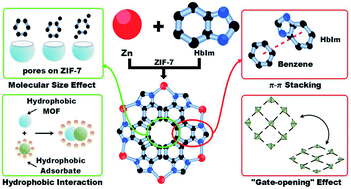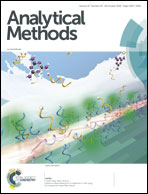Evaluation of the adsorption and desorption properties of zeolitic imidazolate framework-7 for volatile organic compounds through thermal desorption-gas chromatography
Abstract
The adsorption mechanism and desorption properties of volatile organic compounds (VOCs) in a zeolitic imidazolate framework (ZIF-7) were studied by on-line thermal desorption-gas chromatography (TD-GC), and a high efficiency method for determination of harmful indoor gas levels has been developed. The loading volume, loading flow rate and desorption temperature were optimized. Additionally, ZIF-7 has been proved to be an effective adsorbent and its adsorption performance is superior to that of commercial Tenax TA and activated carbon. It has been proved that ZIF-7 is an ideal adsorbent for VOCs. It was suggested that there are hydrophobic interactions, π–π stacking effects, “gate-opening” effects and molecular size effects between adsorbates and ZIF-7. Therefore, the developed ZIF-7-based TD-GC method offered an excellent performance with a detection limit of 1.22–2.38 ng (S/N = 3), a quantification limit of 4.05–7.94 ng (S/N = 10), and a good linearity (R2 = 0.99), and relative standard deviation values (RSD, n = 5) were found to be in the range of 1.69–7.97%, and tube-to-tube reproducibility for three parallel tubes was 8.01%.

- This article is part of the themed collection: Analytical Methods Recent HOT articles


 Please wait while we load your content...
Please wait while we load your content...